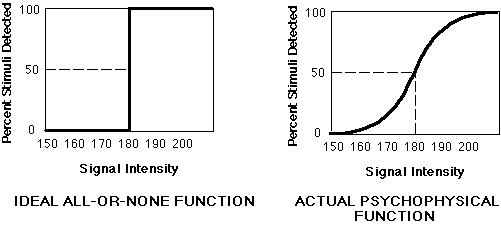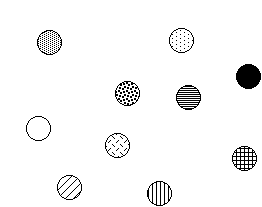
<<Back to Cognition Class Home Page
---------------------------------------------------------------------------------------
Monday, April 13Signal detection theory
Sensory memories
--------------------------------------------
Top-down and bottom-up processes: When what we know about the world does not ALWAYS affect what we see.
--------------------------------------------
STIMULUS DETECTION (Donders task A)
Detection is the simplest act of perception. It corresponds to the question: "Have you seen that strange flying object?" "Have you heard that noise?". Detection refers to the act of deciding whether a particular stimulus was present or absent.
The first and traditional way to approach the detection problem is the study of perceptual thresholds: What is the smallest stimulation that allows detection? What is smallest difference in stimulation that we can detect as difference in sensation?
Absolute threshold is the smallest stimulation that we can perceive. For example, the smallest light intensity that we can see, or the smallest sound intensity that we can hear. PSYCHOPHYSICS is the discipline that studies thresholds. There are several methods to study absolute thresholds. All these methods however, make the same assumptions: (1) the only variable that affects thresholds is the intensity of the stimulation; (2) sensation is an all-or-none phenomenon. Either we detect the stimulus or we do not detect the stimulus.
A consequence of these assumptions is that there is a particular value of intensity that a person can always perceive and a smaller value that a person can never perceive. However, the psychophysic function that relates sensation with physical intensity is a continuous function that goes from zero to 1, without a sharp transition between a no-perception and a perception point.

The Signal Detection theory considers detection is a more complex way. According to this theory, there is not a single process that determines whether a person will respond "yes" or "no" in a psychophysics experiment, but TWO PROCESSES. The first is a process of sensory detection of the signal and the second is a process of decision making.
DETECTION: The process of detection is influenced by the intensity of the stimulus. According to the signal detection theory, we always perceive stimuli in a background of noise. Sometimes this is because the environment is noisy (for example when we try to follow a conversation during a noisy party). Even if external noise is not present, however, our sensory system has a certain level of noise (for example, the activity of neurons that fires a certain number of action potentials even when not stimulated). Therefore, the signal detection theory does not consider detection as an "absolute" process, but always a process of DISCRIMINATION: we need to discriminate a possible signal from a background of noise. This is why the psychophysical function is not all-or-none but follows that curvilinear trend (FIGURE 3.7). The intensity of the stimulus produces a greater separation between the distribution of the noise and the distribution of the noise+signal, making more probable that the signal will be detected. So, according to this theory, detection is PROBABILISTIC, not absolute, and depends on the particular level of noise and of the intensity of the signal in each trial.
A measure of the difference between noise and signal distribution is d' or SENSITIVITY.
DECISION: After we determine d', still we cannot determine how a person will respond. There is a second variable that influences the response, and this is ß or response criterion. Let's assume that I give you these instructions: "I will pay you 1 dollar any time you correctly detect the signal". What is the best strategy in this case? Probably the best strategy is to say "yes" even if you are not very sure that you saw something, so your response criterion will be very low, you will respond yes even if you are not completely sure. But if the instructions are: "I will pay you 1 dollar any time you correctly detect the signal and you will lose 2 dollars any time you report that there was a signal when in fact no signal was presented". In this case, you will be a lot more careful in your report, and you will probably say "yes" only when you are absolutely sure that the signal was present. In real life, the response criterion is related to the risk created by detecting a signal that was not present (FALSE ALARM) and to the risk created by not detecting a signal that was present (MISS).
To study the process of signal detection, the experimenter fills this table, counting how may correct detections (HITS) or rejections each participants make, and how many false alarms and misses. These four numbers allow to compute the values of d' and ß.
SIGNAL PRESENT SIGNAL ABSENT
YES HIT FALSE ALARM
NO MISS CORRECT REJECTION
In Summary:
ASSUMPTIONS OF THE SIGNAL DETECTION THEORY:
(1) The detection of a signal is probabilistic and depends on the level of noise and the intensity of the signal in each trial.
(2) The response in each trial depends on two parameters that can be independently manipulated:
(a) sensitivity (measured by d')(b) response criterion (measured by ß)
(3) Sensitivity and response criterion corresponds to two different processes of sensory detection and decision making.
SENSORY MEMORIES
It is common experience that when we turn off the light for some second we can still "perceive" the room we are in. For example, we can move around without bumping into the furniture or reach for an object without error. However, this "impression" is very brief and after a certain interval we "forget" the precise location of all the object in the room. This experience corresponds to the presence of a particular kind of memory that is called sensory memory. This type of memory is extremely precise and detailed but very short.
The first to study this type of memory was George Sperling. Earlier experiments studied what was called the "span of apprehension", that is how many items we can perceive in a single glance. If I put on a table a certain number of objects for a very short time you will probably report accurately up to 5 objects. These observations led to the conclusion that very short presentations of a visual configuration allow us to perceive just a small number of items. This is very evident in COUNTING.
If I briefly present a configuration like this:

It's very easy for you to decide how may circles there are.
However, if I briefly present this configuration to you:

You will be probably unable to tell me precisely how many circles there are. This is a typical experiment of "SPAN OF APPREHENSION".
Sperling thought that what these experiments were measuring was not really how much we can perceive, but what we can remember of what we perceived. To confirm his intuition he used a very elegant experimental paradigm that he called "PARTIAL REPORT". His idea was that we can perceive a very large number of items, but that the information in this perceptual representation fades away very rapidly. So, when we are asked to report these items we can report only a limited number during the period in which the perceptual representation is still present.
FIGURE 3.8
Sperling presented three rows of 4 letters for 50 ms and asked people to report all the letters they could remember. In this condition, similar to the span of apprehension experiments, people could report only a few letters.
In the partial report condition, after the presentation of the stimulus, a signal was presented that indicated which row had to be reported. In this condition, the report was almost perfect, indicating that people "remembered" all the items presented.
In other experiments, Sperling showed that this sensory representation contains only physical/perceptual information. For example, people could report items based on the position or color, but not on the basis of the sound or of the category (letter or number).
Neisser called this type of representation ICONIC MEMORY and he proposed that was a PRECATEGORICAL REPRESENTATION, that is, a representation that contains only perceptual information but not more abstract information (as, for example, category or sound).
Also in the auditory modality there is a similar ECHOIC MEMORY. The echoic memory lasts longer than the iconic memory but it seems to retain less information. Similarly to the iconic memory, the echoic memory is PRECATEGORICAL, and does not contain information about category, meaning etc.
---------------------------------------------------------------------------------------